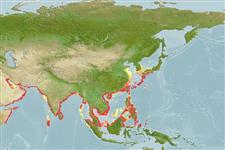>
Clupeiformes (Herrings) >
Dorosomatidae (Gizzard shads and sardinellas)
Etymology: Nematalosa: Greek, nema, -atos = filament + Latin, alausa = a fish cited by Ausonius and Latin, halec = pickle, dealing with the Greek word hals = salt; it is also the old Saxon name for shad = "alli" ; 1591 (Ref. 45335).
Eponymy: Marcus Élieser Bloch (1723–1799) was a German physician and naturalist specialising in ichthyology. [...] (Ref. 128868), visit book page.
More on author: Bloch.
Environment: milieu / climate zone / depth range / distribution range
पारिस्थितिकी
समुद्री; स्वच्छ जल, अलवण जल; खारा; ऐनाढरोमस (Ref. 51243); गहराई सीमा 0 - 30 m (Ref. 6898). Tropical; 38°N - 1°N, 47°E - 136°E (Ref. 188)
Indo-West Pacific: Gulf of Aden north to the Persian Gulf, then eastward to the Andaman Sea, South China Sea and the Philippines, and north to southern tip of Korea. Also reported from Durban Bay in South Africa based on a single juvenile (Ref. 3259).
Length at first maturity / आकार / वज़न / Age
Maturity: Lm 16.2 range ? - ? cm
Max length : 27.2 cm TL पुल्लिंग / अलिंग; (Ref. 122095); common length : 15.0 cm SL पुल्लिंग / अलिंग; (Ref. 188)
पृष्ठीय रीढ़ (सम्पूर्ण) : 0; पृष्ठीय सौफट रेज़ (सम्पूर्ण) : 15 - 19; गुदा कांटा: 0; ऐनल सौफट रेज़: 21 - 25. Diagnosis: Body rather deep, its depth about 34-41% of standard length, belly with 17-20 + 9-13 scutes, total 28-32 scutes; anterior arm of pre-operculum with the third infra-orbital bone immediately above it, no fleshy gap between; mouth inferior, lower jaw strongly flared outward; last dorsal finray filamentous; pectoral axillary scale present; hind edge of scales distinctly toothed; a dark spot behind gill opening (Ref. 188). Resembles Nematalosa galatheae, which has spots along the flank and a smooth hind edge to scales; Nematalosa arabica, N. come and N. japonica all have a distinct fleshy triangular area above the anterior arm of the pre-operculum and none have toothed scale edges; no other clupeid in the distribution area of Nematalosa nasus has a filamentous dorsal finray (Ref. 188).
Known from estuaries and coastal areas, occasionally ascending into the upper reaches of the tidal zone (Ref. 12693). A filter-feeder. Marketed fresh, dried-salted or boiled. Made into fish balls. Very bony.
Whitehead, P.J.P., 1985. FAO Species Catalogue. Vol. 7. Clupeoid fishes of the world (suborder Clupeoidei). An annotated and illustrated catalogue of the herrings, sardines, pilchards, sprats, shads, anchovies and wolf-herrings. FAO Fish. Synop. 125(7/1):1-303. Rome: FAO. (Ref. 188)
IUCN Red List Status (Ref. 130435: Version 2024-1)
Threat to humans
Harmless
Human uses
मात्स्यिकी: लघु वाणिज्य
साधन
Special reports
Download XML
इंटरनेट स्रोत
Estimates based on models
Preferred temperature (Ref.
123201): 25.2 - 29.2, mean 28.6 °C (based on 1229 cells).
Phylogenetic diversity index (Ref.
82804): PD
50 = 0.5005 [Uniqueness, from 0.5 = low to 2.0 = high].
Bayesian length-weight: a=0.00871 (0.00765 - 0.00991), b=3.05 (3.02 - 3.08), in cm total length, based on LWR estimates for this species (Ref.
93245).
Trophic level (Ref.
69278): 2.2 ±0.09 se; based on food items.
Generation time: 1.2 ( na - na) years. Estimated as median ln(3)/K based on 1
growth studies.
लौटाव (Ref.
120179): ऊंचा, न्यूनतम जनसंख्या दुगनी समय अवलागत 15 महीने। (Preliminary K or Fecundity.).
Prior r = 1.13, 95% CL = 0.74 - 1.69, Based on 2 data-limited stock assessments.
Fishing Vulnerability (Ref.
59153): Low vulnerability (18 of 100).
Climate Vulnerability (Ref.
125649): Low vulnerability (16 of 100).
Nutrients (Ref.
124155): Calcium = 235 [125, 406] mg/100g; Iron = 1.85 [1.05, 3.13] mg/100g; Protein = 18.8 [17.6, 19.9] %; Omega3 = 0.356 [0.203, 0.646] g/100g; Selenium = 40.2 [19.5, 82.2] μg/100g; VitaminA = 16.5 [6.1, 40.6] μg/100g; Zinc = 2.19 [1.54, 3.23] mg/100g (wet weight);
